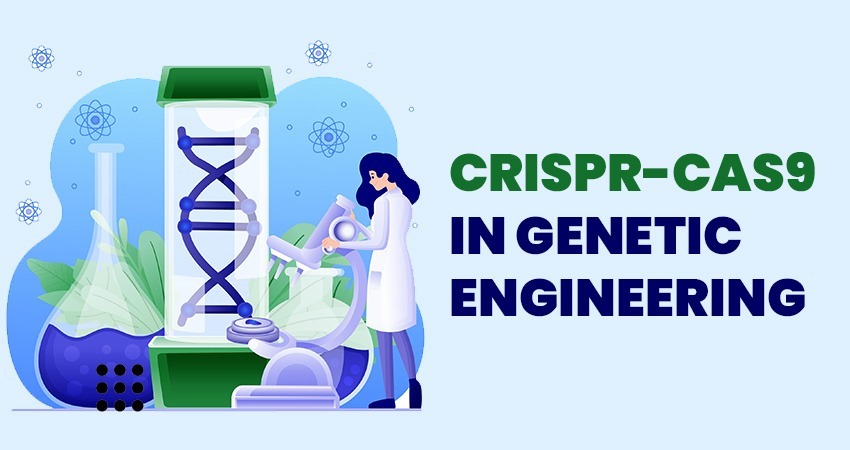The use of CRISPR-Cas9 in genetic engineering (Genetic Engineering) from Engineers Heaven's Idea / Prospect

Genetic engineering has changed the
world of science. It has made impossible things possible. At the heart of all
these advancements is CRISPR-Cas9. This tool has revolutionized the way genes
are edited. It is fast, precise, and cost-effective. But how exactly does it
work, and why is it so revolutionary? Let's explore.
What is CRISPR-Cas9?
CRISPR stands for "Clustered
Regularly Interspaced Short Palindromic Repeats." It's a naturally
occurring system in bacteria. These little guys use this mechanism to resist
viruses. In other words, it is this Cas9, which is like the molecular scissors:
the DNA would get cut off at that spot.
Scientists discovered that this system
could be applied in genetic engineering. They guide Cas9 to a specific gene and
cut or modify DNA by doing so. This has now opened doors to endless
possibilities.
How Does CRISPR-Cas9 Work?
The process is simple. First, scientists
design a guide RNA (gRNA). This RNA is complementary to the DNA sequence they
wish to target. The guide RNA guides Cas9 to the targeted site in the genome.
Once at the site, Cas9 cuts the DNA.
After the cut, the cell repairs the DNA.
Scientists can manipulate this repair. They can delete, modify, or insert
genes. This makes CRISPR-Cas9 so powerful.
Applications of CRISPR-Cas9
CRISPR-Cas9 is not only a scientific
tool. It is the solution to many real-world problems. Its applications are
vast, from healthcare to agriculture and even environmental science.
1. Medicine
CRISPR is a game-changer in medicine.
Scientists use it to treat genetic diseases such as sickle cell anemia and
cystic fibrosis. These diseases result from faulty genes. CRISPR can correct
these errors at the DNA level.
CRISPR also holds promise in cancer
research. By editing immune cells, scientists can enhance their ability to
fight tumors. This is already being tested in clinical trials.
2. Agriculture
The agricultural industry has greatly
benefited from CRISPR. Crops can now be engineered to resist pests and
diseases. They can also be made more nutritious and better suited to changing
climates.
For instance, CRISPR has been used to
develop fungal-resistant wheat. It has also enhanced the yield and quality of
rice.
3. Environmental Science
CRISPR is also helping solve
environmental problems. Scientists are researching its application in
eradicating invasive species. Others are using it to minimize the carbon
footprint of industries.
For example, scientists are engineering
algae strains that absorb more carbon dioxide. This can significantly reduce
greenhouse gases.
The Advantages of CRISPR-Cas9
Why has CRISPR-Cas9 been in the
spotlight? For good reason:
● Accuracy: CRISPR locates and identifies
specific genes with high precision.
● Speed: The process is quicker than the traditional genetic engineering methods.
● Cost-Effectiveness: It is less expensive,
thereby increasing its reach among researchers.
It can be used in almost all fields of
science.
Ethical Issues
Despite the benefits, CRISPR-Cas9 raises
ethical concerns. The use of human embryos for editing is a controversial
issue. Many are concerned about its misuse, such as creating "designer
babies."
There are also concerns about unintended
edits. CRISPR is precise, but off-target effects can occur. Scientists are
working hard to minimize these risks.
Governments and regulatory bodies play a
crucial role here. Clear guidelines are essential to ensure ethical use.
The Future of CRISPR-Cas9
The potential of CRISPR-Cas9 is endless.
Researchers are trying to make it even more accurate. They are also studying
its application in space. Imagine editing genes to grow crops on Mars!
In the next years, CRISPR may end genetic
diseases. It can produce crops that feed the world. It can even reverse
environmental damage.
A Resource for Aspiring Engineers
If you are interested in such
revolutionary technologies, the good news is there for you. Engineer's Heaven is
a great place where your inquisitiveness would be fueled.
Go to Engineer’s Heaven for such great
articles and resources. It is a hub for education and innovation. Whether you
are a student or a professional, the platform provides something for everyone.
You will get updates on emerging
technologies such as CRISPR. You will learn more tools to improve your skills
also.
(Disclaimer: This statistics could be different in different part of World and Different timeline. this statistics has been generated based on data available till 2025 or relavant time span.)

The Wall